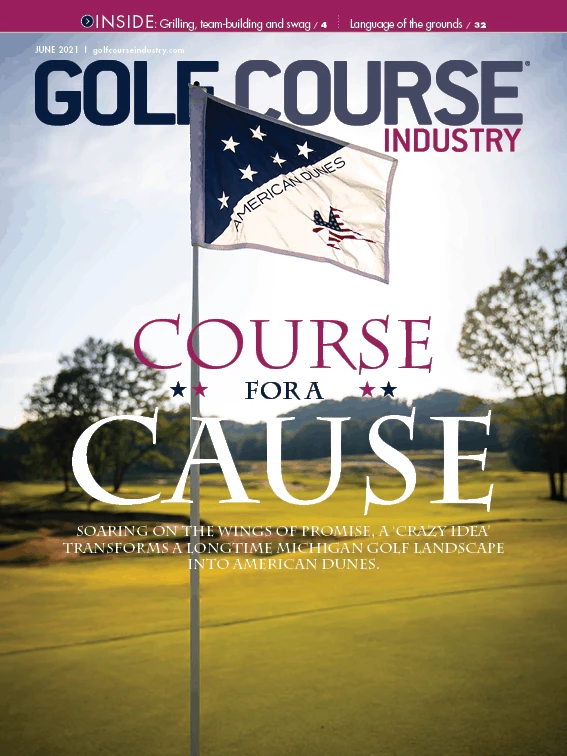
Multiple diseases are ingrained into turfgrass management vernacular. Dollar spot. Spring dead spot. Pythium. Fairy ring. Brown patch. Snow mold. Anthracnose. Know them. Develop calculated programs to control for them.
Summer patch falls into a different category. There’s nary a mention of it within the pages of venerable turf textbooks.
Even people trained to study and subsequently suggest tactics to control turf disease had rarely fielded questions about summer patch until last year.
“Summer patch is a disease I didn’t get many calls about before 2020,” says BASF senior technical representative Jen Browning, who works with golf courses in the Western United States. “I talked to a lot of superintendents who had a perennial program for summer patch. They would put it out and didn’t think much about it. But then all up and down the West Coast last year, I started getting a lot of calls about summer patch outbreaks, which I thought was interesting because nobody ever called me about the disease before.”
So, yes, the time is right to delve more into summer patch. Patch diseases are frequently spotted on golf courses, but the differences between summer patch and others such as brown patch and take-all patch are stark.
“With summer patch,” Browning says, “by the time you see symptoms, the fungal activity associated with the pathogen happened weeks or months ago and you’re just seeing expression from the disease being active in the past.”
Summer patch has a crescent- or ring-shaped appearance and the disease can reoccur in the same spots over extended periods. Any state or region where cool-season grass is maintained on golf courses can be ripe for a potential summer patch outbreak. The disease can pose problems on Poa annua, Kentucky bluegrass, multiple fescue varieties and … bentgrass.
“I have given talks on summer patch and people at the end ask, ‘Does bentgrass get this? Are you sure bentgrass gets this?’” Browning says. “Bentgrass absolutely gets it. In the past, people assumed only Poa got it.”
Like many diseases, increased stresses and demands on turf are forcing superintendents to be more diligent about summer patch control. Spots on the course that experience “sudden-dry down conditions,” or where superintendents have taken corrective action to improve drainage can demonstrate increased susceptibility to summer patch, Browning says.
Devising agronomic and spray programs with the specific purpose of limiting summer patch isn’t practical in most cases. But practices that superintendents are already implementing can help matters. Browning’s thoughts on a few practices as they relate to summer patch:
- Irrigation: “One thing that will help is deep, infrequent irrigation and syringing on hot afternoons.”
- Fertility: “Avoid nitrogen deficiency.”
- Soil pH: “You are more susceptible if you are above 6, but I don’t know a whole lot of superintendents who reported that they were trying to manage pH just with summer patch in mind.”
- Sunlight: “Same thing with sunlight. I know a lot of supers do things to manage their tree population on the course, but it wasn’t specifically about summer patch.”
- Mowing heights: “Low mowing heights certainly exacerbate it, but I don’t know that superintendents who are mowing for playability will necessarily raise the mowing height for summer patch unless they are experiencing symptoms later in the summer and are trying to push roots; then they may choose to raise mowing heights a bit to try to recover.”
When it’s time to spray, don’t be misled by the disease’s name. Action must be taken well before summer. Soil temperatures of 65 degrees should spark the commencement of preventative programs.

“The sweet spot for disease activity in the transition zone and a little bit north is actually early June,” Browning says. “That’s when the disease is active and that means you need to have your fungicide applications out 28 days before that or maybe even earlier. Really monitor your soil temps and be prepared with your program ahead of time.”
The spray programs Browning recommends involve rotating products with different FRAC codes and modes of action. DMI, QoI and SDHI fungicides are the staples of those rotations. A pair of products BASF introduced in 2019 — Maxtima® fungicide and Navicon® Intrinsic® brand fungicide — expanded rotational options available for summer patch control. Navicon Intrinsic is a broad-spectrum DMI and strobilurin combination.
“Our program is based on foundational applications of our two newest introductions, which are Maxtima fungicide and Navicon Intrinsic brand fungicide, as well as Lexicon® Intrinsic brand fungicide,” Browning says. “The two Intrinsic products are plant-health based and they will give you some resilience and stress management in addition to excellent disease protection. They help you get through tournament season and some of the stresses from heat, traffic and compaction. Those are some of the additional features we like to bring to the party when we are trying to build a program that helps turf respond to the dry-down events and the different things we put turf through during the tournament season and heavy-play season.”
The peak golf season coincides with periods when summer patch begins appearing on playing surfaces. Once the disease is spotted, serious damage has already occurred, thus Browning’s emphasis on making summer patch part of a preventive spray program. Unfortunately, scant experience with the disease put some courses in the region she covers, which includes coastal California, Oregon and Washington, in peril last summer.
“It was mostly people who didn’t have it on their radar because they didn’t have to deal with it in the past,” she says. “They had low to moderate pressure and they didn’t have vigorous summer patch programs in place because they weren’t overly worried about the disease. They didn’t have the conditions in previous years to really get major summer patch outbreaks. It became a real discussion point for lots of people. I had gone back to superintendents who had perennial summer patch problems and they always put out applications the instant they hit the temperature point you need to begin making your preventive application. I have asked them, ‘Why are you so careful about this disease?’ They all said, ‘Because I’ve been burned by it before, and it’s very difficult to recover from.’” ?
Always read and follow label directions.
Honor, Intrinsic, Insignia, Xzemplar, Lexicon, Maxtima and Navicon are registered trademarks of BASF.
© 2021 BASF Corporation. All rights reserved.

Note: Any sales of the products after registration is obtained shall be solely on the basis of the EPA-approved label, and any claims regarding product safety and efficacy shall be addressed solely by the label.

Explore the June 2021 Issue
Check out more from this issue and find your next story to read.
Latest from Golf Course Industry
- Carolinas GCSA raises nearly $300,000 for research
- Advanced Turf Solutions’ Scott Lund expands role
- South Carolina’s Tidewater Golf Club completes renovation project
- SePRO to host webinar on plant growth regulators
- Turfco introduces riding applicator
- From the publisher’s pen: The golf guilt trip
- Bob Farren lands Carolinas GCSA highest honor
- Architect Brian Curley breaks ground on new First Tee venue






